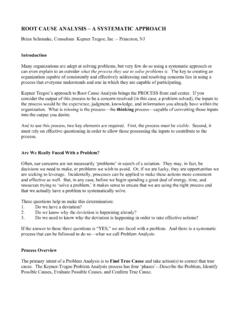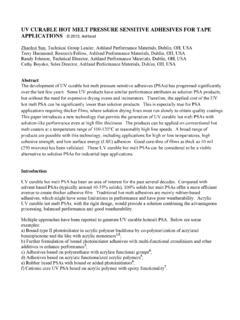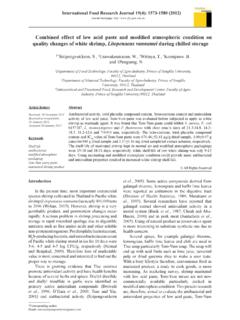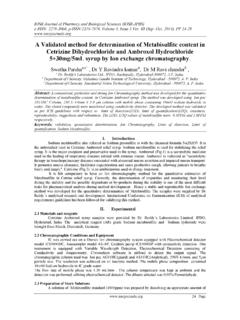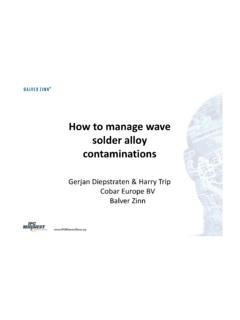Transcription of The Effect of Hindered Phenol Stabilizers on Oxygen ...
1 The Effect of Hindered Phenol Stabilizers on Oxygen induction Time (OIT) Measurements, and The Use of OIT Measurements to Predict Long Term Thermal Stability Philip Jacoby, Vice President of Technology, Mayzo Inc., Norcross, GA Introduction: The Oxygen induction Time (OIT) test is an accelerated aging test that is often used to predict the long term stability of hydrocarbon materials including plastics, rubbers, and adhesives. The OIT test can also be used to measure the level of effective antioxidant present or remaining in a polymeric material after some environmental exposure. Since thermal-oxidatative degradation requires the presence of Oxygen at elevated temperatures, the OIT test is designed to accelerate this degradation in order to achieve meaningful comparisons in a short period of time.
2 The standard OIT test is performed according to ASTM D3895, and uses a Differential Scanning Calorimeter (DSC). A few mg of the material to be tested are introduced into the DSC at room temperature, and the sample is heated to about 200 oC under a nitrogen atmosphere. When 200 oC is reached the cell is maintained in an isothermal condition, and the gas is changed from nitrogen to Oxygen . The pressure and flow rate of the Oxygen are maintained at 35 kPa and 50 cc/min, respectively. Under these conditions the stabilizer is consumed over time until it is totally depleted. At this point the polymer sample catastrophically degrades or oxidizes liberating additional heat (exotherm).
3 The time it takes for this exotherm to appear from the time that the Oxygen is introduced is reported as the OIT time, and is a measure of the thermal stability of the material. A typical OIT curve for polyethylene is illustrated in Figure 1. A high pressure version of the OIT test can also be performed using a cell that can withstand a pressure of 5500 kPa, and this test follows ASTM D5885. The high pressure test is generally used when lower test temperatures are desired, such as 150 oC. Sometimes higher test temperatures will bias the test results for certain types of antioxidants, as discussed later in this paper.
4 If the standard OIT test were used at these low temperatures the duration of the test would be very long. At high Oxygen pressure the concentration gradient of Oxygen atoms across the specimen s surface increases, and this accelerates the oxidation process and reduces the testing time. The OIT value generally follows a linear relationship with antioxidant concentration, as illustrated in Figure 2. This behavior makes the OIT test a useful quality control procedure for tracking the concentration of the antioxidant. Background of the OIT Test: The OIT procedure was first developed at Bell Laboratories as a test method for screening polyethylene insulation used in telephone wire and cable for its oxidation resistance.
5 The method first became available as a Western Electric specification1 and later as an ASTM Standard2. It is well known that the effectiveness of antioxidants, as measured by the OIT test, is sensitive to the temperature range where the measurement is made3. A number of factors influence this sensitivity including changes in the degradation and stabilization mechanism, volatility of the antioxidant at high test temperatures, etc. These difficulties can be minimized by moving the test temperature closer to that of the end-use temperature, and then using a high pressure DSC to further accelerate the test. 1 Western Electric Manufacturing Standard 17000, Section 1230 (1971) 2 ASTM D3895, Test method for Oxidative induction Time of Polyolefins by DSC.
6 3 Howard, , and Gilroy, , Polym. Eng. Sci., 15, 268-271 (1975) Introduction To Polymer Stabilization: All organic polymers will degrade when exposed to certain environmental conditions such as high temperatures, mechanical shear, and high energy radiation ( UV exposure). The presence of Oxygen will often accelerate this degradation. The first step in the degradation process is usually the loss of a hydrogen atom from the polymer chain due to this energy input. This polymer free radical , [R*], can then react with an Oxygen (O2) molecule to form a peroxy radical [ROO*] which will in turn abstract a hydrogen atom from another polymer chain to form a hydroperoxide [ROOH].
7 The hydroperoxide can split into two new free radicals, [RO*] + [*OH], which continue to propagate the reaction to other polymer molecules. For certain polymers, such as polypropylene, a polymer chain containing a free radical is likely to split into two smaller chains, while for polyethylene chains, the free radical often causes one chain to graft onto another chain leading to crosslinking. One way to interrupt this process is to incorporate an antioxidant into the polymer. There are different types of antioxidants that interrupt the degradation cycle at different points, and these types are listed in Table 1.
8 The primary antioxidants, such as Hindered Phenol compounds, are designed to react with the initial free radicals that are formed, as illustrated by the schematic in Figure 3. These Hindered phenols are often referred to as radical scavengers, since they react rapidly with peroxy radicals thereby breaking the degradation cycle. The various Hindered phenols can differ from one another in molecular weight, number of Hindered Phenol groups per molecule, volatility, and solubility in the polymer. Higher molecular weight compounds, such as BNX 1010, are less volatile and more effective at higher temperatures and at longer exposure times.
9 A secondary antioxidant such as a phosphite compound can interrupt the degradation cycle at another point by reacting with the hydroperoxides that are formed. A schematic of this function is illustrated in Figure 4. A combination of a primary and a secondary antioxidant is particularly effective in minimizing degradation, since the two act in a synergistic manner. The choice of the particular combination of Stabilizers used and the stabilizer level required, is influenced by the severity of the thermal history experienced by the polymer, as well as the needed end-use lifetime. Another class of Stabilizers are the light or UV Stabilizers , and the most common types are listed in Table 2.
10 The Hindered Amine Light Stabilizers (HALS) react with the free radicals that are formed when a high energy UV photon causes a chemical bond in the polymer to break. The HALS molecule is actually regenerated as it mops up the free radicals, so that HALS are often very effective as long term Stabilizers . HALS can also be used to provide thermal stability at the appropriate temperature range. The UV absorbers promote stability by absorbing harmful UV radiation before it leads to the production of free radicals. In choosing the most appropriate stabilizer package, it is important to know what temperature range the polymer will be exposed to when stabilization is required.



